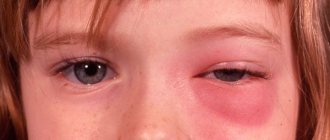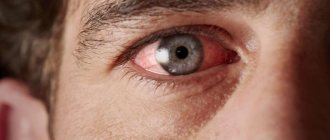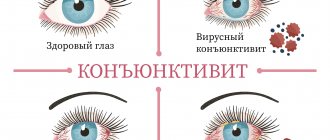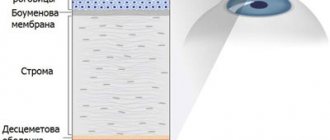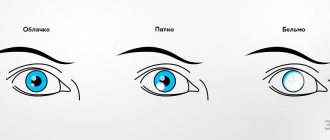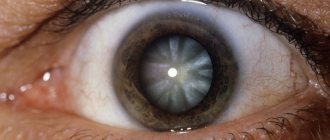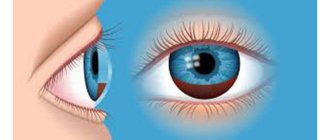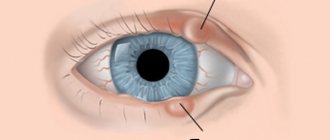Eye diseases caused by the herpes virus are called ophthalmoherpes. Such conditions are very diverse; they are often accompanied by infectious complications, metabolic damage to eye tissue, glaucoma and cataracts. Herpetic keratitis is diagnosed in both adults and children. The causative agent of the disease is the herpes simplex virus (the first antigenic type), which causes various disorders.
Types of keratitis
Tree herpetic keratitis
is the most common type of disease. It is characterized by such manifestations as the occurrence of acute pain in the initial phase of the disease, photosensitivity of the eyes, and the appearance of “spots” in the field of vision. As blisters develop on the surface of the cornea, patients notice lightning flashing and spots appearing before the eyes. The gradual detachment of the epithelium provokes ulceration of the tissue.
Metaherpetic keratitis
. Often develops as a phase of the disease appearing after dendritic keratitis. The background for such an anamnesis, as a rule, is the lack of treatment or inadequate hormonal therapy. A feature of this type of disease is the rejection of the area of the cornea, which has already been affected by ulcers during the development of keratitis. Further exacerbation of the disease is accompanied by an increase in the area of the cornea in which pathological processes occur. Swelling and hardening of the cornea leads to decreased clarity of vision, and a viral infection only accelerates its loss.
Keratouveitis
. With this disease, patients report noticeable tingling and sudden sharp attacks of pain in the eyes. Other manifestations of keratouveitis include increased lacrimation and decreased vision clarity. In addition, damage to the iris of the eyeball and inflammation of the network of small eye vessels develops. Further development of the disease leads to the release of pus from the anterior chamber in combination with a sharp increase in intraocular pressure. These factors lead to patients suffering from pressing headaches of various locations (forehead, bridge of the nose, temples). Dilation of the pupils is observed, when examining a light source, a halo is noticeable around it, and attacks of nausea are noted.
Discoid keratitis
. An accumulation of eye fluid and infected blood develops in the thickness of the cornea, which leads to damage to the central part of the cornea. Pain in the eyeball becomes chronic due to an increase in the density of the cornea.
If we also take into account the decrease in its sensitivity, such manifestations of the disease as blurred vision or limited vision become clear.
All types of herpetic keratitis are serious and should not be treated on your own. You will only harm your eyes, which can lead to dire consequences. This disease should only be treated by professionals and should be treated as a whole.
Classification
Herpetic keratitis is classified depending on the age of the person. The primary type appears in a child. Children's bodies cannot yet produce antibodies that are resistant to the virus.
The secondary type of disease is divided into types:
- Vesicular form. Bubbles appear inside the eye, which are filled with gray liquid. When they burst, small ulcers and scars form. These defects leave cloudy spots on the cornea.
- Metaherpetic keratitis. The infection penetrates into the deep layer of the eye. Therefore, the cornea becomes cloudy. Erosion occurs. Due to scarring from wounds, vision is reduced. The inflammatory process spreads to the area of blood vessels in the anterior part of the eye.
- Tree form. Condensed scars form on the eye vessels. The disease progresses slowly, without complications.
- Discoid keratitis. The pathology occurs in an acute form and manifests itself in the form of scars and swelling of soft tissues. This type is usually caused by untreated glaucoma.
Sometimes the listed types of herpetic keratitis lead to fragility of the corneal epithelium. A person experiences a gradual deterioration in vision.
Symptoms of herpetic keratitis
The symptoms of herpetic keratitis in the initial phase are similar to the signs of bacterial infection and combine the following manifestations:
- increased lacrimation;
- increase in photosensitivity;
- redness;
- decreased clarity of vision due to swelling of the cornea.
Usually the lesion is asymmetrical in nature, affecting one eyeball. Small vesicular formations form on the cornea itself, followed by ulceration of the affected area. It is important to consider that, unlike bacterial infection, infection with the herpes simplex virus cannot be treated with antibiotics. This pathology is also characterized by a tendency to progress.
As a rule, at the initial stage of keratitis, minor changes occur in the structure of the cornea. Remission can occur even without specific treatment. However, with each relapse of the disease, the virus penetrates deeper into the corneal tissue, which is accompanied by gradual destruction of its surface. As a result, such manifestations of the disease as the appearance of ulcers, a decrease in the sensitivity of the cornea and its clouding increase.
Infection with the herpes simplex virus can act as a trigger for the ingrowth of blood vessels into the cornea, a decrease in visual abilities, and even loss of vision altogether.
Manifestations characteristic of herpetic keratitis:
- the perorbital zone and the skin of the eyelids become covered with blistering rashes;
- development of unilateral acute follicular conjunctivitis;
- enlargement of the preauricular lymph nodes;
- the likelihood of developing secondary obstruction of the lacrimal canals.
Symptoms and development of the disease
Keratitis of herpetic origin develops gradually. First, the patient is diagnosed with a mild bacterial infection. A person does not see a doctor because he may not pay attention to symptoms such as red eyes for no reason and watery eyes. As the symptoms progress, photosensitivity and corneal swelling appear. Vision decreases.
The first sign of herpetic keratitis is the appearance of small blisters on the cornea. Over time, they burst and ulcers form in their place. Vision deteriorates. If one eye is affected, then only that one. If both organs are involved, then on both sides.
People often try to treat themselves using antibacterial drops. However, such treatment has no effect, since the virus is not affected by antibacterial agents. Symptoms progress rapidly.
The first episodes of the disease can be tolerated relatively easily. This is due to the fact that the disease does not immediately affect the deep layers of the cornea. However, with each subsequent relapse, the patient's condition progressively worsens.
Diagnosis of herpetic keratitis
When the first signs of the disease appear, you should consult an ophthalmologist. Using special equipment, your doctor will perform a physical examination and measure your intraocular pressure. A type of examination also includes a technique using fluorescein. It consists in the fact that drops containing this product are applied to the cornea, after which it is possible to assess the degree and area of its damage using special filters of a narrowly directed light flux.
Additional diagnostic methods combine cytological and virological studies. Thus, the attending physician may prescribe a sample of epithelial tissue of the cornea, conjunctiva, as well as a study of tear fluid.
Unusual cases of herpetic keratitis may require the organization of a provocative allergy test. If, in the case of focal administration of an antiherpetic vaccine, increased pain and exacerbation of inflammation are observed, the test is positive.
Laboratory research methods combine:
- fluorescent antibody method
- nephelometry with allergens of viral, microbial, medicinal and tissue nature
- intradermal and focal tests using antigens such as tuberculin, brucellin and herpes vaccine
One of the most accurate ways to diagnose herpetic keratitis is to evaluate the polymerase chain reaction (PCR), during which DNA amplification occurs, including the DNA of pathogenic organisms of the herpes series.
Treatment of herpetic keratitis
A feature of the treatment of herpetic keratitis is that this pathogen is highly adaptable to antiviral drugs. In addition, the drugs mentioned, as a rule, have a wide range of contraindications, and therapy using them has a number of limitations. In general, it is preferable to organize treatment of herpetic keratitis in a hospital setting.
A common method of treatment is the prescription of antiviral drops and ointments. Internal administration of drugs such as Idoxuridine, Acyclovir, Valacyclovir is also effective. Pain can be relieved by instilling lidocaine into the eyes.
The list of modern drugs that have demonstrated effectiveness in treating herpetic keratitis includes Isoprinosine and Okoferon. Isoprinosine is available in tablet form and is distinguished not only by its antiviral, but also by its immunomodulatory effect. The medication is taken for two weeks. Basically, this medicine provides remission due to a noticeable strengthening of the immune system.
A special feature of Okoferon is that interferon, which is not highly stable, in this drug increases the pharmacological effect for up to two weeks. Moreover, already on the second or third day of taking Okoferon, patients’ pain decreases, lacrimation stops, and photophobia disappears. This drug is used in the form of drops, which are applied to each eye, 2 drops at two-hour intervals.
Since Okoferon promotes the intensification of phagocytosis and the production of antibodies, its use is accompanied by a decrease in corneal edema, resorption of the infiltrate and improved vision. In addition, relief of inflammation occurs noticeably faster than with other medications.
Among the time-tested methods of treating herpetic keratitis, it is worth noting electrophoresis. During this procedure, a tampon with an interferon solution is placed on the cornea, and the transfer of the drug to the affected surface occurs under the influence of a constant electric current. One electrophoresis session lasts up to five minutes. As the affected layers of the cornea are destroyed, the current strength also changes. The procedure cycles are repeated until the altered epithelium is replaced with healthy tissue. Electrophoresis can significantly improve the condition of patients with dendritic keratitis within two weeks, and with ulcerative keratitis within three. A slight clouding may remain at the site of the infiltrate, which subsequently has an extremely weak effect on the quality of vision in persons undergoing electrophoresis therapy.
As for the various folk methods for curing herpetic keratitis, which patients can find on various online forums and resources, experts categorically do not recommend resorting to such methods. There are two reasons for this. Firstly, the causative agent of the disease is so “insidious” that the diseases caused by it should be treated with more aggressive drugs than lotions and decoctions. And secondly, self-medication can result not only in a serious exacerbation of the disease, but also in complete loss of vision.
Any therapeutic measures for keratitis should be carried out only with the knowledge and as prescribed by an ophthalmologist. In addition, it is important to consider the time factor. In cases where the pathogen turns out to be resistant to antiviral drugs, damage to the central part of the cornea has developed and rapid loss of vision is observed, surgical intervention is necessary. Surgery is usually indicated for those patients whose condition has not improved significantly during treatment with conservative methods for two months.
The most common type of intervention is scraping the altered epithelium and then applying antibiotics to it. In cases where the measures taken are insufficient, penetrating or layer keratoplasty can be effective. These operations involve complete removal of the affected tissue.
Penetrating keratoplasty
During the preoperative period, the patient is provided with treatment for diseases that can affect the results of the intervention. Before surgery, the attending physician prescribes antibiotic drops. Immediately before the procedure, you should stop eating. The intervention itself can be performed either using local eye anesthesia or under general anesthesia. In both cases, the operation is not accompanied by pain. The choice in favor of the first or second method of anesthesia mainly depends on the age of the patient and individual tolerance of certain drugs. During the operation, a catheter is inserted into the patient's vein for concomitant drug infusion.
Penetrating keratoplasty is performed using a microscope. The surgeon separates the area of the cornea intended for removal radially using special instruments. Then the donor's cornea is placed in place of the separated tissue, which is sewn to the recipient's cornea with the finest threads. At the final stage, the resulting surface is assessed and an injection is given to prevent infection.
During the rehabilitation period, it is important to control the pressure inside the eyeball. Typically, you will need to wear a gauze bandage for up to one month. In addition, the patient should strictly avoid applying external pressure to the operated area and even touching the eye. The recovery process can be accelerated by using special ointments and drops.
Possible disorders that may develop after surgery include the likelihood of bleeding, suture dehiscence, infection, as well as the individual characteristics of the patient’s recovery after anesthesia. There is also a possibility of developing cataracts or detachment of the donor area of the cornea. The latter disorder is the most common complication. Even if this happened, there is no particular cause for concern: modern methods of restorative therapy can eliminate such consequences. In general, about 90% of keratoplasty operations occur without any complications.
Treatment with folk remedies
Treatment of herpetic keratitis of the eyes is not carried out with folk remedies. To enhance the therapeutic effect, folk remedies are used only in combination with other methods. But traditional medicine should be used strictly under the supervision of an ophthalmologist. The main thing is that the diagnosis is made correctly.
For this disease, you can use juices, ointments and decoctions. To reduce the symptoms of keratitis, relieve pain and fear of light, you can use sea buckthorn oil
. The oil is instilled 2 drops every 3 hours.
If a cataract has formed, you can use celandine
(Fresh Juice). Squeeze the juice and add propolis extract (1:3). Add 2 drops. If your eyes begin to sting, this treatment is not suitable for you.
Kalanchoe
It is known for its healing properties and is a good remedy for the treatment of keratitis. Dilute the juice and water (1:1), apply a swab or napkin soaked in the solution to the eyes from 5 to seven times (for 15 minutes).
Plantain decoction is very effective in the treatment of herpetic keratitis.
. Pour boiling water over 1 tablespoon of dry leaves and leave to steep for 6 hours. Strain the broth and rinse the eyes affected by keratitis.
When treating herpetic keratitis, all patients (without exception) must follow a special diet that includes foods with protein, vitamins and microelements. How can you eat fats and carbohydrates?
It is better to treat herpetic keratitis (all its types) in a hospital. Sometimes an ophthalmologist may allow treatment at home. However, this can only happen at the initial stage and under the supervision of a doctor. All recommendations will need to be followed. Do not self-medicate.
After a course of treatment, preventive measures should be taken. First of all, hygiene. When wearing lenses, you must do everything according to the instructions. Eye protection must be observed. Dust and dirt should not get into them. No foreign infections.
Complications
If therapy was not carried out on time or completely, and the patient was treated independently, this can lead to complications for the patient:
- the appearance of erosion and ulcers on the cornea, which causes clouding and deterioration of visual acuity;
- blindness in one or both eyes, if the disease has reached the terminal stage and no treatment has been carried out;
- in people with immunodeficiency, the herpes virus can spread throughout the body, causing other lesions, for example, on the skin, genitals, or mouth;
- spread of herpes infection to the brain;
- a bacterial infection that occurs as a result of a disruption in the composition of the normal microflora of the superficial structure of the eyes.
If the patient is a child under 3 years of age, herpes infection always causes a sharp increase in body temperature, more than 39 degrees. In the absence of antipyretic drugs, he may develop seizures, which will lead to damage to small or large parts of the brain.
Prevention of herpetic keratitis
An effective way to prevent herpetic keratitis is specific therapy in the form of a course of intravenous injections of a polyvalent drug. A stable remission is formed after five such injections, which provide a barrier to the activation of various types of herpes virus. The disadvantage of this type of prevention is the considerable price of the product.{banner_gorizontalnyy3}
It is possible to strengthen the immune system using non-medicinal methods. General measures to counter relapse include the following recommendations:
- try to eliminate stress;
- avoid mass gatherings during ARVI epidemics;
- avoid hypothermia.
As auxiliary measures, such folk remedies as washing the eyes with tincture of plantain leaves or lotions with decoctions of other medicinal herbs are effective. In addition, periodic use of antiviral medications is recommended. The most effective are Acyclovir and Valaciclovir. In general, all measures to strengthen the immune system should be considered useful, since a weakening of the defense system contributes to the development and exacerbation of inflammation.
Also, for the purpose of prevention, contact with people who have viral infections and, above all, herpes should be excluded. If you are doing any procedures, you need to treat everything with septic tanks, keep all medical instruments, baths, pipettes, and devices in hermetically sealed containers.
Eye injuries (microtraumas) should be prevented. Promptly detect and treat conjunctivitis, blepharitis, dacryocystitis, as well as immunodeficiency and other diseases. They can cause the appearance and development of herpetic keratitis.
Contact lenses must be used and stored correctly. Sometimes, it is dirty lenses that can cause herpetic keratitis. Every evening, clean them of dust and dirt using special solutions and containers. Wash your hands thoroughly before handling your lenses.
Antiherpes therapy should be carried out to avoid infection with herpes. Keep your immune system healthy and take eye vitamins. If you strictly follow all the doctor’s instructions, the disease can be defeated. The main thing is to be patient during treatment, since the treatment will be long.
Causes
Today, experts identify eight types of herpes, five of which can affect the organs of vision:
- Herpes simplex virus. It is the most common causative agent of keratitis.
- Herpes simplex virus type 2.
- Shingles virus, herpes zoster. May also cause chickenpox.
- Epstein-Barr virus.
- Cytomegalovirus.
Infection occurs in childhood or adolescence through contact with a sick person. The source of infection can be anyone, from classmates to parents. After infection, there may be no symptoms, but blisters appear in the lip area. Some people develop stomatitis.
After infection, blisters may appear in the lip area, as well as stomatitis.
Forecast
Various forecasts can be made. It all depends on the cause of herpetic keratitis, how complex it is and what the complications are. If keratitis is treated promptly and rationally, the lesion can be eliminated. After treatment, slight clouding of the cornea may remain. With deep keratitis, with ulcers, vision is significantly reduced. Check it regularly with an ophthalmologist, carry out preventive medications and other treatments. Then you will have a chance that herpetic keratitis will not recur. There is no need to be exposed to stressful conditions, do not become overcooled.
Herpetic keratitis is an unpleasant disease that can be overcome if you take care of your eyes, follow hygiene rules, and diet. See your doctor regularly, get examined, and if the first symptoms appear, immediately run to the doctor. Take care of yourself.
